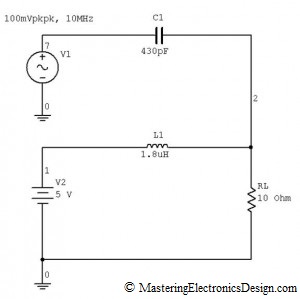In allaboutcircuits.com forum, a question was posted: How can I combine an AC source of known frequency and amplitude with a DC power supply?
I thought this is an interesting problem, so here is the solution.
Subsequent messages clarified the requirements: 5V power supply, and the load needs 0.5A, which would make the load 10 ohms. The signal that rides on top of the DC voltage has to be 20 mVpkpk.
First, we need an inductor in series with the power supply to block the AC component. In this schematic, V1 is the 10 MHz generator and V2 is the 5V power supply.
The inductor’s impedance should be at least 10 times higher than the load, so that most of the generator energy goes into the load. If we note XL the inductor impedance, then XL = 10·RL, so XL = 100 ohms, and L1 can be calculated
The result is L1 = 1.59 uH, with a standard value of 1.8 uH.
Then, we need a capacitor in series with the generator, to block the DC component from coming into the generator output. The generator, through this capacitor, “sees” the load in parallel with the inductor, considering that the power supply output impedance is low, close to zero. Because of that, the capacitor impedance, together with the parallel combination load and inductor impedance form an attenuator. The signal amplitude on the load, can be written as follows:
where VL is the AC signal amplitude on load, VG is the generator amplitude, RLparXL is the load and inductor in parallel
and XC is the capacitor impedance. Using the above relation the capacitor impedance becomes
Taking into consideration that VL = 20 mVpkpk, L = 1.8 uH and choosing the generator amplitude VG = 100 mVpkpk, C1 becomes
with the result C1 = 433.07 pF. A standard value for C1 is 430 pF.
The generator amplitude can be slightly adjusted around 100 mVpkpk, so that the signal on load is exactly 20 mVpkpk.
And what is the current the generator sources on load? This can be easily calculated noting that the generator “sees” a capacitor in series with RL in parallel with L1. Since XC + RLparXL = 45.94 ohms, the generator output current is 2.18 mApkpk.
A 0.5 A, 1.8 uH inductor can be easily found. The generator sends into the power supply approximately 0.2 mApkpk signal. If this is not desirable, the inductor value can be increased with the disadvantage that its size increases.
Note that this method considers the load as being pure resistive. If the load has reactive components, RL has to be replaced by the combined impedance values of the resistive and reactive components.






